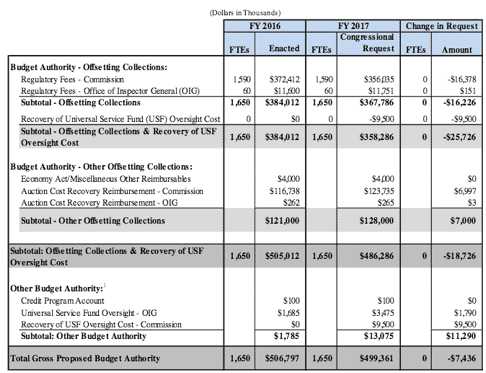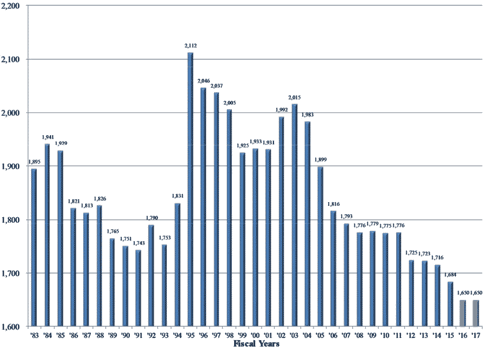FCC FY2017 Budget Proposal
09 02, 16 17:47

FCC's proposed budget for FY17 has now been made public. The above table shows the bottomline numbers: if adopted, staffing would stay the same at 1650 FTE but spending would decrease by $7M. Hw this would be done in an agency that has been historically underfunded compared to its staff size remains unclear. The historical staffing data shown below almost makes one yearn for the Reagan years!

IB, OET, and WTB will see slight staffing increases - presumably at the expense of the EB field staff many of whom are being terminated as a result of "Field Modernization". (EB decreases from 252 FTE in FY15 to 211 FTE in FY17 while IB goes from 110 to 111, OET goes from 87 to 91, and WTB goes from 212 tp 216.) The Inspector General will remain at 60 FTE, the same level as FY16 but a major increase form FY15's level of 38. (You might think that with that many people OIG could do its whole statutory job, but there is no indication that it will change from its "blind eye" policy to the effectiveness of the Commission and its programs other than USF.)
Since FY 2016 spectrum issues are not an explicit FCC goal so one can not see directly how spectrum staffing is changing. FCC's strategic goals are now:
- Promoting Economic Growth and National Leadership
- Protecting Public Interest Goals
- Making Networks Work for Everyone
- Promoting Operational Excellence
Spectrum policy appears to be part of the first goal.
The action part of the budget has $1,250,000 for "Optimization for New Spectrum Opportunities" which is described as:
The optimization team will help us analyze and study options for makng new spectrum available, including through sharing scenarios, to ensure we are maximizing the amount of useful commercial spectrum. They will develop optimal band plans accommodating incumbent uses and demonstrate the value of additional clearing or sharing as necessary.
Note that this proposed sharing is only for "commercial spectrum".
We have been critical of EB's failure to pay relocation costs of employees thus reducing career mobility and preventing exchange of field personnel with headquarters elements of FCC. The budget reveals that in 2015 zero was spent on "Transportation of Things" - a category that includes moving expenses. But in the enacted FY16 budget $100k was included and the FY17 request includes $101k. But since this includes relocation as well as shipping equipment and supplies it is a negligible sum for an nationwide organization even at its new reduced size.
In FY15 EB spent zero on equipment - perhaps you can see why they had a morale problem? The FY16 budget is $225k but the FY17 proposal $2.8M. Can EB actually spend such money well in view of how few central staff they have now for planning field enforcement and the fact they are downsizing the Atlanta area operation that designs and plans equipment?
It is interesting that the budget talks (p. 66) about "the lighting and marking of radio transmitting towers" as an EB responsibility but Field Modernization specifically called for reducing activity here due to "high compliance".
OET's equipment budget goes from $250k to $253k. A look at the price of radio test equipment will show that this does not go very far, basically 1-3 items.
blog comments powered by Disqus



![Validate my RSS feed [Valid RSS]](valid-rss-rogers.png)

